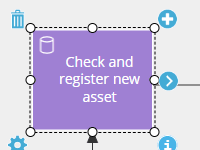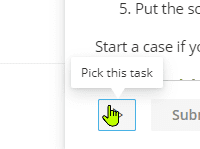
How to start with process improvement

Process improvement is key to staying competitive in a changing world. At the same the ‘improvement in process’ topic can be overwhelming. This guide is written for managers that want to start with process improvement and need a basic overview of where to go for additional information and tooling.
Read this guide to get an intro to the following aspects of process improvement:
What is process improvement?
Process improvement is the systematic approach of identifying, analyzing, and enhancing existing workflows or systems to increase efficiency, productivity, quality, and overall performance within an organization. It involves the strategic application of methodologies, tools, and continuous refinement to eliminate waste, streamline operations, and achieve better outcomes.
So why care about improvements in processes? Because of many tangible business benefits.
The benefits of process improvement
Measurable business benefits from process improvements can show in various ways:
| Example: | Measurable Benefit: | |
| Cost Reduction: | An organization implements lean principles in its supply chain management, reducing excess inventory and streamlining logistics. | Decrease in inventory holding costs by 20% within six months, leading to significant savings in storage expenses and better cash flow management. |
| Enhanced Productivity: | A software development team adopts agile methodologies and automated testing processes. | Increased productivity by 30%, measured through a higher number of completed features or user stories per sprint, leading to faster product delivery and reduced time to market. |
| Quality Improvement: | A healthcare facility implements a Six Sigma approach to reduce medical errors in patient care. | Reduced error rates by 50% within a year, measured through incident reports and patient feedback, leading to higher patient satisfaction scores and improved reputation. |
Measuring improvements involves setting clear Key Performance Indicators (KPIs) aligned with the specific goals of the process improvement initiative. Whether it’s reducing costs, increasing productivity, improving quality, or achieving other objectives, having quantifiable metrics helps track progress and evaluate the success of the implemented changes. It also helps to build a business cases for management.
“Measurement is the first step that leads to control and eventually to improvement. If you can’t measure something, you can’t understand it. If you can’t understand it, you can’t control it. If you can’t control it, you can’t improve it.”
H. James Harrington

So with a clear business cases which method should you use?
Business process improvement methodologies
At its most basic level can be done via two basic methodologies:
Process improvement
This is about making gradual changes over time and includes sub-methods within the Lean philosophy with frameworks such as Lean Six Sigma and Kaizen.
Process reengineering (BPR)
BPR is about radical transformation where existing methods are replaced with new. Sub-methods such as agile and Total Quality Management (TQM) would fall in this category.
Both process improvement and process reengineering aim to enhance organizational efficiency, but they differ in scope and approach. Here are some pros and cons of each:
The Pros and Cons of Process Improvement vs Reengineering
| Pros | Cons | |
| Process Improvement | Incremental Changes: It focuses on gradual, continuous changes, making it easier for teams to adapt. Preserves Existing Processes: It builds on current structures, often leveraging employee knowledge and existing systems. Cost-Effective: Generally, it involves lower costs and less disruption compared to reengineering. Employee Engagement: Encourages involvement from all levels, fostering a culture of continuous improvement. | Limited Transformation: Sometimes, it might not create significant breakthroughs or transformative changes. Slow Progress: Due to its incremental nature, the improvements might take time to yield substantial results. Potential for Overlooking Big Changes: It might miss opportunities for radical innovation by focusing on small-scale enhancements. |
| Process Reengineering | Radical Transformation: Offers the potential for major, transformative changes within the organization. Efficiency Boost: Can significantly enhance efficiency by redesigning processes from scratch. Innovation and Breakthroughs: Allows for thinking outside the box and adopting entirely new approaches. Streamlining and Simplification: Often simplifies complex processes, making them more straightforward and efficient. | High Cost and Disruption: It typically involves significant costs and can disrupt the organization’s operations. Resistance to Change: Employees might resist such massive changes, leading to implementation challenges. Risk of Failure: Due to its radical nature, there’s a higher risk of failure if not executed well. Loss of Institutional Knowledge: Reengineering might discard certain elements of existing systems, potentially losing valuable institutional knowledge. |
Deciding between the two, it depends on the your specific needs, resources, and the extent of change required. In many cases, a combination of both approaches might be the most effective strategy, leveraging continuous improvement while occasionally implementing more radical changes for transformative impact – or following a reengineered process with continuous process improvement.
In the following, we will look at different examples and which basic methodology they used.
Examples of Gluu’s Process Improvement features

Simple process mapping
Map with five basic shapes to simplify understanding and use by employees across all levels.

Task progress tracking
Let users start and stop tasks to show real-time progress and track value-adding time spent.
Examples of process improvement
Here are three real-life examples of process improvement:
Inventory Management Enhancement:
| Issue: | A retail company faced overstocking of certain items while running out of others, leading to increased holding costs and missed sales opportunities. |
| Improvement: | Implementing a just-in-time inventory system, analyzing sales patterns, and adjusting orders based on demand forecasts reduced excess inventory and minimized stockouts. |
| Result: | Lowered holding costs, improved cash flow, and increased customer satisfaction due to consistently available products. |
| Type: | Process Reengineering |
Call Center Streamlining:
| Issue: | A call center experienced long wait times and high call abandonment rates due to complex call routing and inefficient processes. |
| Improvement: | Redesigned call flow, trained staff in problem-solving techniques, and implemented a new customer relationship management (CRM) system to provide agents with better information. |
| Result: | Reduced wait times, increased first-call resolution rates, and improved customer satisfaction scores. |
| Type: | Process reengineering |
Manufacturing Process Optimization:
| Issue: | A manufacturing plant faced high defect rates and long production lead times, impacting product quality and delivery times. |
| Improvement: | Introduced lean manufacturing principles, implemented quality control measures at each stage, and reorganized the assembly line to reduce unnecessary movement and waiting times. |
| Result: | Decreased defect rates, shorter lead times, increased productivity, and improved overall product quality. |
| Type: | Process improvement |
These examples demonstrate how process improvement involves identifying specific problems within a process, implementing changes or new methodologies, and measuring the impact of those changes to achieve tangible improvements in efficiency, quality, or customer satisfaction.
With the ‘What’ and the ‘Why’ covered it is time to look at the ‘How’. Typically any process improvement initiative goes through seven steps:
7 Process Improvement Steps
Below is a short summary of the key process steps. For more details on this read our article on “Process improvement process steps“.
- Identifying the Need for Improvement:
- Conduct a thorough evaluation of existing processes, gathering data and metrics.
- Engage stakeholders for insights into areas requiring immediate attention.
- Consider seeking external expertise and leveraging technology for insights.
- Defining the Goals and Objectives:
- Set SMART goals aligned with the organization’s strategic objectives.
- Analyze internal/external factors, involve diverse stakeholders, and communicate goals effectively.
- Foster a collaborative culture, ensuring shared understanding and commitment.
- Collecting and Analyzing Data:
- Gather data from customer feedback, performance metrics, and process documentation.
- Utilize tools like process mapping, statistical analysis, and benchmarking.
- Make informed decisions and prioritize improvement initiatives based on insights.
- Developing the Improvement Plan:
- Involve cross-functional teams to identify root causes and set actionable strategies.
- Assess required resources, establish realistic timelines, and define measurable KPIs.
- Implement lean/agile methodologies, ensuring a comprehensive and adaptable plan.
- Implementing the Improvement Plan:
- Execute the plan, ensuring clear communication, support, and training for employees.
- Address challenges or resistance through regular feedback and communication channels.
- Measuring and Monitoring Results:
- Track identified KPIs and compare against baseline data, using dashboards or scorecards.
- Analyze progress regularly, identifying deviations and taking timely corrective actions.
- Continuous Improvement Strategies:
- Establish feedback loops, encourage employee suggestions, and update processes regularly.
- Embrace technology for automation and AI, fostering a culture of innovation and learning.
By following these steps, organizations can systematically enhance their processes, drive efficiency, and adapt to evolving business landscapes.
How to engage people toward process improvement
Engaging people in process improvement is crucial for successful implementation and sustained change. Here are some effective ways to involve and motivate individuals in the improvement process:
- Communication and Transparency:
- Clearly communicate the purpose, goals, and expected outcomes of the improvement initiative.
- Ensure transparency about the process, progress, and how individual contributions contribute to the larger goals.
- Leadership Support and Involvement:
- Secure active support and involvement from leadership to demonstrate commitment and set an example.
- Leaders should champion the initiative, emphasizing its importance and fostering a culture that values improvement.
- Employee Involvement and Empowerment:
- Encourage and empower employees to contribute ideas and suggestions for process improvement.
- Create forums or platforms for brainstorming sessions, idea sharing, and feedback collection.
- Training and Skill Development:
- Offer training programs to equip employees with the necessary skills and knowledge for process improvement methodologies.
- Provide resources or access to tools that facilitate their participation in improvement initiatives.
- Recognition and Rewards:
- Acknowledge and celebrate contributions and successes in process improvement.
- Implement a reward system that recognizes individuals or teams for their innovative ideas and impactful contributions.
- Cross-Functional Collaboration:
- Encourage collaboration across departments or teams, fostering a diverse range of perspectives and ideas.
- Create cross-functional teams to tackle specific improvement projects, promoting collaboration and knowledge sharing.
- Feedback Mechanisms:
- Establish feedback loops to gather input from employees on the effectiveness of implemented changes.
- Act on feedback by making adjustments based on suggestions or addressing concerns promptly.
- Continuous Improvement Culture:
- Embed a culture that values continuous improvement as an ongoing practice rather than a one-time project.
- Encourage a mindset that embraces change, experimentation, and learning from both successes and failures.
- Clear Roles and Responsibilities:
- Define roles and responsibilities clearly to ensure everyone understands their involvement in the improvement process.
- Provide guidance on how each person’s role contributes to achieving the overall goals.
- Storytelling and Sharing Successes:
- Share success stories and case studies from process improvement efforts within the organization.
- Highlight the positive impacts, benefits, and outcomes achieved through these initiatives to inspire others.
By implementing these strategies, organizations can foster an environment where people feel motivated, empowered, and engaged in contributing to continuous process improvement.
👉 Recommendation: Prioritize a culture of engagement and empowerment for process improvement. Ensure clear communication, leadership involvement, and employee empowerment. Foster collaboration, offer training, and recognize contributions to create a sustainable culture of continuous improvement.
Below I will show you and example of a continuous process improvement process that encompasses all domains of change:
5 tips to master process improvements
Mastering process improvement as an organization requires a strategic approach and a focus on key success factors. Here are five critical factors that contribute to success in this endeavor:
- Leadership Commitment and Support:
- Key Aspect: Active involvement and visible support from top leadership are crucial.
- Impact: When leaders champion process improvement, it sets the tone for the organization, demonstrating its importance and fostering a culture that values continuous enhancement.
- Employee Engagement and Empowerment:
- Key Aspect: Engaging employees at all levels, encouraging their involvement, and empowering them to contribute.
- Impact: Employees who feel valued and empowered are more likely to actively participate, provide valuable insights, and drive successful implementation.
- Clear Goals and Objectives:
- Key Aspect: Defining specific, measurable, and achievable goals aligned with the organization’s overall strategy.
- Impact: Clear objectives provide direction, focus efforts, and help measure progress, ensuring that process improvement initiatives align with broader organizational objectives.
- Robust Process and Tools:
- Key Aspect: Having well-defined methodologies, tools, and resources to facilitate process improvement initiatives.
- Impact: Equipping teams with effective tools and standardized processes streamlines efforts, enables data-driven decision-making, and ensures consistency in approach across the organization.
- Continuous Learning and Adaptability:
- Key Aspect: Cultivating a culture of continuous learning, adaptability, and openness to change.
- Impact: Organizations that embrace learning from successes and failures, adapt to evolving circumstances, and encourage innovation are better positioned to sustain process improvements over the long term.
These factors interplay and reinforce each other, forming the foundation for successful process improvement initiatives. When organizations prioritize these critical success factors, they create an environment conducive to mastering process improvement and driving lasting positive change.
👉 Recommendation: To master process improvement, prioritize leadership commitment, employee engagement, clear goals, robust processes, and a culture of continuous learning. These five key factors, when integrated into your organization’s approach, will pave the way for sustained success in process improvement efforts.
Conclusions
Mastering process improvement is not merely a goal but a journey that requires a holistic and strategic approach. By placing a strong emphasis on leadership commitment, actively engaging employees, setting clear goals, implementing robust processes, and fostering a culture of continuous learning, organizations can navigate this journey with confidence. These five key factors serve as the cornerstones of sustained success, ultimately leading to enhanced efficiency, innovation, and competitiveness in today’s dynamic business landscape. Embracing these principles will empower organizations to evolve, adapt, and thrive in an ever-changing world. Start by selecting the right tools for process management with our BPM Software Selection Guide.
Frequently Asked Questions
The main methodologies are structured approaches to enhancing business processes. Six Sigma focuses on reducing defects and variations, Lean aims to eliminate waste, TQM emphasizes continuous quality improvement, BPR involves radical process redesign, Kaizen encourages small incremental changes, and Agile prioritizes flexibility and collaboration in development processes.
It involves a systematic approach to making processes more efficient and effective. It starts with defining the process and its objectives, measuring its current performance, analyzing data to identify issues, making improvements (like streamlining steps or adopting new technologies), and implementing controls to sustain the improvements over time.
It holds significance due to its role in enhancing efficiency, reducing costs, improving quality, maintaining competitiveness, fostering adaptability, promoting innovation, ensuring compliance, and engaging employees.



